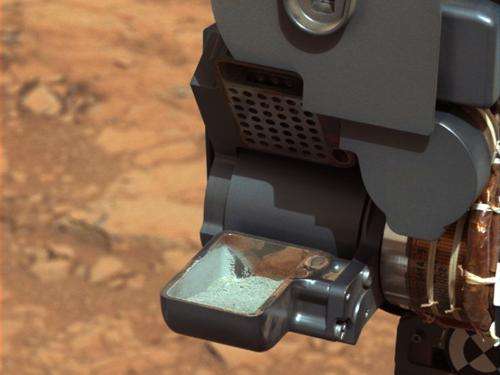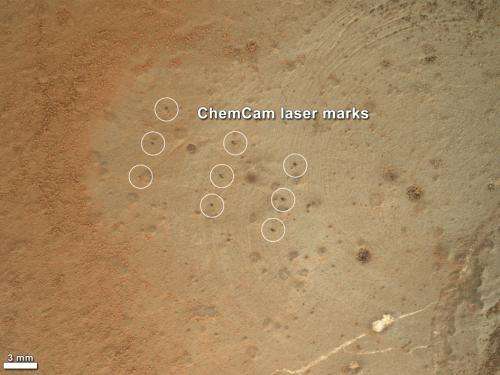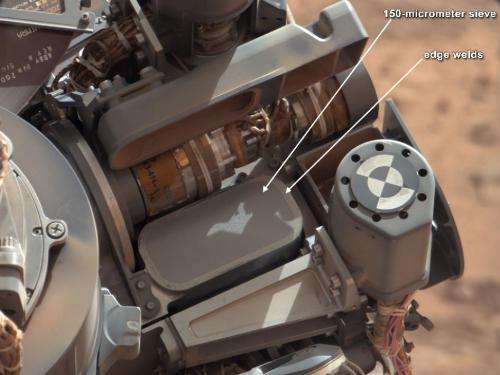This image from NASA's Curiosity rover shows the first sample of powdered rock extracted by the rover's drill. The image was taken after the sample was transferred from the drill to the rover's scoop. In planned subsequent steps, the sample will be sieved, and portions of it delivered to the Chemistry and Mineralogy instrument and the Sample Analysis at Mars instrument. The scoop is 1.8 inches (4.5 centimeters) wide. The image was obtained by Curiosity's Mast Camera on Feb. 20, or Sol 193, Curiosity's 193rd Martian day of operations. The image has been white-balanced to show what the sample would look like if it were on Earth. A raw-color version is also available. Credit: NASA/JPL-Caltech/MSSS
(Phys.org)—NASA's Mars rover Curiosity has relayed new images that confirm it has successfully obtained the first sample ever collected from the interior of a rock on another planet. No rover has ever drilled into a rock beyond Earth and collected a sample from its interior.
Transfer of the powdered-rock sample into an open scoop was visible for the first time in images received Wednesday at NASA's Jet Propulsion Laboratory in Pasadena, Calif.
"Seeing the powder from the drill in the scoop allows us to verify for the first time the drill collected a sample as it bore into the rock," said JPL's Scott McCloskey, drill systems engineer for Curiosity. "Many of us have been working toward this day for years. Getting final confirmation of successful drilling is incredibly gratifying. For the sampling team, this is the equivalent of the landing team going crazy after the successful touchdown."
This image from the Mars Hand Lens Imager (MAHLI) on NASA's Mars rover Curiosity shows details of rock texture and color in an area where the rover's Dust Removal Tool (DRT) brushed away dust that was on the rock. This rock target, "Wernecke," was brushed on the 169th Martian day, or sol, of Curiosity's mission on Mars (Jan. 26, 2013). This image was recorded on Sol 173 (Jan. 30, 2013). The image shows nine small pits created by the rover's Chemistry and Camera (ChemCam) laser during its analysis of the target, one of four potential drill targets considered. Ultimately, this site was not chosen for the rover's first drilling. The rest of the features are natural to the rock, and include fractures, white veins, gray and white nodules, pits and tiny dark grains. Remaining clumps and specks of dust can also be seen. The scale bar at lower left is 0.12 inches (3 millimeters). Credit: NASA/JPL-Caltech/MSSS/Honeybee Robotics/LANL/CNES
The drill on Curiosity's robotic arm took in the powder as it bored a 2.5-inch (6.4-centimeter) hole into a target on flat Martian bedrock on Feb. 8. The rover team plans to have Curiosity sieve the sample and deliver portions of it to analytical instruments inside the rover.
The scoop now holding the precious sample is part of Curiosity's Collection and Handling for In-Situ Martian Rock Analysis (CHIMRA) device. During the next steps of processing, the powder will be enclosed inside CHIMRA and shaken once or twice over a sieve that screens out particles larger than 0.006 inch (150 microns) across.
This image shows the location of the 150-micrometer sieve screen on NASA's Mars rover Curiosity, a device used to remove larger particles from samples before delivery to science instruments. The sieve lies within the Collection and Handling for In-situ Martian Rock Analysis (CHIMRA) structure, which is on the end of the rover's turret, or arm. This picture was taken by the rover's Mast Camera on Sol 81, the 81st Martian day of the mission (Oct. 28, 2012). The color has been white-balanced to show the scene as it would appear on Earth. Credit: NASA/JPL-Caltech/MSSS
Small portions of the sieved sample later will be delivered through inlet ports on top of the rover deck into the Chemistry and Mineralogy (CheMin) instrument and Sample Analysis at Mars (SAM) instrument.
In response to information gained during testing at JPL, the processing and delivery plan has been adjusted to reduce use of mechanical vibration. The 150-micron screen in one of the two test versions of CHIMRA became partially detached after extensive use, although it remained usable. The team has added precautions for use of Curiosity's sampling system while continuing to study the cause and ramifications of the separation.
The sample comes from a fine-grained, veiny sedimentary rock called "John Klein," named in memory of a Mars Science Laboratory deputy project manager who died in 2011. The rock was selected for the first sample drilling because it may hold evidence of wet environmental conditions long ago. The rover's laboratory analysis of the powder may provide information about those conditions.
Provided by NASA


























